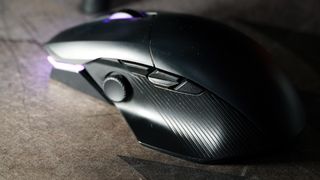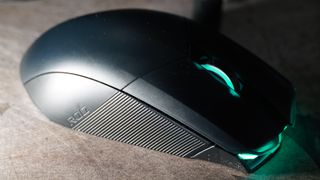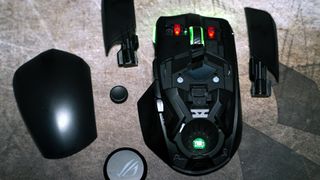Tom's Hardware Verdict
The Asus ROG Chakram X has amazing specs and impressive features, but its penchant for misfires is inexcusable at any price, let alone at $150.
Pros
- +
Buttons aplenty
- +
Uniquely customizable
- +
Long battery life
Cons
- -
Spotty software
- -
Touchy switches
- -
All buttons aren’t always within reach
Why you can trust Tom's Hardware
If you’re hunting for the best gaming mouse, you’d probably expect to get something incredibly solid, if not quite perfect for your specific needs, when you break the $100 barrier. At a glance, the Asus ROG Chakram X seems like the kind of mouse that would provide an exceptional experience, as it’s simply oozing features and capable technology.
The Asus ROG Chakram X clearly has the making of a high-end gaming mouse ready to contend for the throne thanks to high sensitivity, options for fast wireless and even faster wired connections, Bluetooth as a backup, snazzy lighting, a load of buttons, an analog joystick, and swappable switches. But Asus didn’t quite fit everything together into a seamless package or polish the final product enough for it to be worth its $150 sticker. What’s even worse is that a glaring flaw makes it completely unreliable for real competitive play.
Design and Comfort of the Asus ROG Chakram X
If it weren’t for the glowing ROG logo on the palm rest, you’d have a difficult time telling the Chakram X was an Asus product at all — it looks like many other gaming mice (specifically, it looks a little like a blend of the Razer Basilisk and the Logitech G502).

The Chakram X has a low arc that’s better-suited for palm grippers with smaller hands, though it can also work for claw and hybrid grips if you have bigger hands. Asus suggests the mouse is meant for palm or fingertip grippers, but the right side provides very little for fingertips to grab. A swept-out thumb rest on the left side and some basic texturing on both sides offer extra grip for fingers, but don’t make for the most confident hold on the mouse when lifted.

While aerial acrobatics may be a struggle for the mouse, gliding across the mousepad isn’t. The mouse sits on three sizable PTFE feet, which allow it to slide smoothly. This makes up for the hefty weight of this mouse, which, at 4.48oz (127g), is considerably heavier than the ultra-light gaming mice that currently proliferate the market.

The Chakram X can put on a nice little light show as it dances about the mousepad, thanks to its nine-zone RGB lighting. The scroll wheel lights up, the palm lights up with a removable ROG badge, and the front edge of the mouse features a multi-zone light bar. The illumination is well-executed, but the placement of the light bar means you’ll hardly ever see it.

Asus has loaded the Chakram X up with buttons and features. It can connect via USB-C to enjoy an 8,000 Hz polling rate for extra-responsive inputs, or it can use a small USB-A dongle for 2.4GHz wireless at a 1,000 Hz polling rate. There’s also Bluetooth as a backup when gaming performance isn’t a priority. The palm rest of the mouse detaches to house the USB dongle when not in use and provides access to the swappable ROG badge.
The main left- and right-click buttons can also pop off, allowing access to the switches beneath, which Asus says can be swapped for other 3-pin mechanical or 5-pin optical switches. Getting the palm and button covers off is easy enough, but it takes some work to get them properly seated when you put them back on, as the magnets that hold them in place try to snatch them away
The scroll wheel has a solid, rubberized finish that provides a good grip, and it’s easy enough to click. All of the thumb controls are a bit of a wash. There are four thumb buttons, and they’re tiny. They’re a little difficult to feel out and even harder to reach without adjusting your hand position in a way that sacrifices grip. The thumbstick, which can serve as an extra four buttons or as an analog control, is very far forward, requiring another hand shift. The stick itself can be swapped out for a long or short stem.
Though the comfort of the ROG Chakram X is lacking for larger hands, and the side buttons feel like a struggle for any hand size, at least the mouse feels sturdily constructed.

The scroll wheel is clickable and has a solid, rubberized finish that provides a good grip. The Chakram X has four thumb buttons and a thumbstick, which can serve as an extra four buttons or as an analog control. Unfortunately, all of the thumb controls are a bit of a wash. The thumb buttons are tiny, difficult to feel, and hard to reach without adjusting your hand position in a way that sacrifices grip. And the thumbstick is placed very far forward, so reaching it requires another shift in hand position. The thumbstick is customizable — it can be swapped for a long or short stem.
The mouse is sturdily constructed, but it’s not very comfortable if you have larger hands (and the side buttons feel like they’d be a struggle for any hand size).
Specifications
| Sensor Type | Optical |
| Sensor Model | ROG AimPoint |
| Sensitivity | 36,000 CPI |
| Polling Rates | 8,000Hz (1,000Hz wireless) |
| Lift-off Distance | Unspecified, adjustable |
| Programmable Buttons | 11 |
| LED Zones and Colors | 9 Zones (3 distinct) RGB |
| Connectivity | 2.4 GHz USB Type-A dongle, Bluetooth, USB Type-A-to-C |
| Weight | 4.48 ounces (127g) |
| Measurements (LxWxH) | 5.42 x 3.01 x 1.69 inches (132.7 x 76.6 x 42.8mm) |
| Battery life | 114 Hours (Qi charging) |
| Software | Armoury Crate |
Gaming Performance of the Asus ROG Chakram X
The Chakram X has a lot of good things going for it when it comes to performance, but it also has some major flaws.
Starting with the good: The Chakram X has a capable sensor with an impressive maximum sensitivity of 36,000 CPI. The mouse matches this with optional 8,000 Hz polling (wired), and tolerates speeds of up to 650 IPS and acceleration of up to 50G. The Chakram X tracked consistently and accurately in competitive gaming tests, and helped me stay largely on target in games such as Overwatch.
The switches underneath the four thumb buttons, the scroll wheel, and main mouse click buttons are also responsive. The thumb buttons, in particular, have none of the mushiness often found in mouse thumb buttons. Unfortunately, thanks to their subpar placement, size, and spacing, it’s hard to put all of the side buttons to use (and the spacing between the side buttons and the thumbstick is even more problematic).
The thumbstick is about 3.25 inches from the back edge of the mouse, and the rearmost thumb button is just 1.75 inches away. It may not seem like much, but the 1.5-inch spacing makes for some difficulty switching between them. While sliding my hand up to center my thumb on the analog stick, my fingers end up really far forward and struggle to reach the scroll wheel. So, while the Chakram X performs the basics well, it does a terrible job of providing the extra control expected at its premium price point.

The mouse’s wireless performance is generally pretty good, but, in all the years I’ve been using wireless mice, I’ve never seen some of the odd behavior I spotted with the Chakram X. For example: I spotted my mouse cursor wiggle around after I stopped moving the mouse. In fairness to the Chakram X, I did test it in an environment littered with other wireless signals, so this could have been the result of interference — but I haven’t noticed any similar issues with other wireless gear.
On the other hand, the battery life of the Chakram X is phenomenal, lasting through plenty of lengthy gaming sessions and workdays without needing a top-up. It can charge up via USB-C but also supports Qi wireless charging.
One big issue looms above the capabilities and foibles of the ROG Chakram X, though. Somehow during the design process, Asus must have missed that slapping the mouse down (as one might when flicking about in an intense game) easily triggers the main left and right click buttons. These triggers get enough momentum that when the mouse lands on the desk, they follow through to depress the switch beneath — and no boosted polling rate or high CPI makes up for dozens of misclicks in-game.
Since both or either button can trigger, it could mean accidentally scoping in at the worst time or firing off a precious round that could have made the difference in a firefight. Maybe there’s a little less mouse slapping or the main mouse buttons are bound to less crucial actions in MMOs, which Asus says this mouse is meant for — but any type of misclick is inexcusable. The switches are hot-swappable, so you could replace them with switches that have a higher actuation force to remedy this — but the first thing required of a new product shouldn’t be a fix.
Features and Software
The Chakram X uses Asus’s Armoury Crate application for control. If you’re just after a tool to tweak settings, Armoury Crate will feel incredibly bloated. It pulls up news, deals, your game library, and more.
Unfortunately, one of the features that didn’t work in my testing was the only one that needed to: mouse settings. Despite trying different connections, different USB ports, restarting, updating firmware, and re-installing, Armoury Crate consistently failed to access the device settings page. Just once, it allowed me to adjust the lighting and make changes to the key bindings and mouse lift-off distance (for which there are two settings). But even when I could access settings, it errored out if I tried to adjust the CPI of the mouse. Considering muscle memory is sacred in keyboard and mouse gaming, this is a huge blunder.
Fortunately, the Chakram X has a trick up its sleeve that helped partially get past this issue. The CPI can still be adjusted by using the scroll wheel and a CPI button on the bottom of the mouse. Simply holding the CPI button briefly and then scrolling with the scroll wheel will begin to adjust sensitivity, then pressing the CPI button again will lock it in. This allowed me to adjust the sensitivity close to what I was comfortable with, but I couldn’t confirm that it was exactly my preferred 2,500 CPI.
Bottom Line
The Asus ROG Chakram X feels like a gymnast going for an incredible aerial maneuver, hitting all the spins and rotations in the air, and then whiffing the landing. There’s a lot of potential under the hood of this mouse, and it’s backed by impressive specs, high-performance connectivity, and excellent battery life.
But Asus didn’t quite nail the mechanics, and the result is a mouse that is way too easy to get misclicks out of and is difficult to use to its full advantage. A couple of small oversights would be forgivable, but the compounding issues for a mouse that costs $150 is hard to excuse.
If you can avoid slapping the mouse down, or you’re already planning on swapping out the switches, the Chakram X might be an option for you. But
If you can avoid slapping the mouse down or are already planning on swapping out for switches with a higher actuation force, the ROG Chakram X might be for you. But if you’re looking for a mouse that has usable thumb buttons and multiple customization options, try the Razer Naga Pro.
-
MoxNix Why didn't you test the mouse with the other set of swappable switches it comes with and tell us if they have the same accidental click problem?Reply

